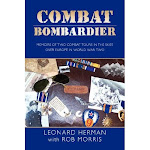 Another of my heroes flew his final mission last week--Jacob 'Jake' Deshazer. Mr. Deshazer was one of the Doolittle Raiders and ended up a POW in Japan for the entire war. Several of his crew-mates were executed by the Japanese, and his treatment was abysmal. His captivity strengthened his Christian faith, and after the war, he returned to Japan as a missionary. In one of history's intriguing stories, one of the men he converted to Christianity was the pilot who led the attack on Pearl Harbor.
Another of my heroes flew his final mission last week--Jacob 'Jake' Deshazer. Mr. Deshazer was one of the Doolittle Raiders and ended up a POW in Japan for the entire war. Several of his crew-mates were executed by the Japanese, and his treatment was abysmal. His captivity strengthened his Christian faith, and after the war, he returned to Japan as a missionary. In one of history's intriguing stories, one of the men he converted to Christianity was the pilot who led the attack on Pearl Harbor. Published: March 23, 2008
Jacob DeShazer, a bombardier in the storied Doolittle raid over Japan in World War II who endured 40 months of brutality as a prisoner of the Japanese, then became a missionary in Japan spreading a message of Christian love and forgiveness, died on March 15 at his home in Salem, Ore. He was 95.

Jacob DeShazer
His death was announced by his wife, Florence.
On April 18, 1942, crewmen in 16 Army Air Forces B-25 bombers, commanded by Lt. Col. James H. Doolittle, flew from the carrier Hornet on a daylight bombing raid that brought the war home to Japan for the first time since the Japanese attack on Pearl Harbor. The raid resulted in only light damage to military and industrial targets, but it buoyed an American home front stunned by Japanese advances during the war’s first four months.
Corporal DeShazer, a native of Oregon and the son of a Church of God minister, was among the five-member crew of Bat Out of Hell, the last bomber to depart the Hornet. His plane dropped incendiary bombs on an oil installation and a factory in Nagoya but it ran out of fuel before the pilot could try a landing at an airfield held by America’s Chinese allies.
Below, Jake Deshazer stands at far right with the rest of Crew, Navigator George Barr; pilot Lt. William Glover Farrow (executed by a Japanese firing squad on October 15, 1942); Engineer-Gunner Sgt. Harold A. Spatz (executed by a Japanese firing squad on October 15, 1942); Co-pilot Robert Hite (POW); and Bombardier Cpl. Jacob Deshazer.
Hite, Barr, and Deshazer were liberated August 20, 1945.
 The last plane off the flight deck, Deshazer's crew takes wing for Japan.
The last plane off the flight deck, Deshazer's crew takes wing for Japan. 
The five crewmen bailed out over Japanese-occupied territory in China and all were quickly captured. In October 1942, a Japanese firing squad executed the pilot, Lt. William G. Farrow, and the engineer-gunner, Sgt. Harold A. Spatz, along with a captured crewman from another Doolittle raid plane. Corporal DeShazer and the other surviving crewmen from his plane, Lt. George Barr, the navigator, and Lt. Robert L. Hite, the co-pilot, were starved, beaten and tortured at prisons in Japan and China — spending most of their time in solitary confinement — until their liberation a few days after Japan’s surrender in August 1945.
Amid his misery, Corporal DeShazer had one source of solace.
“I begged my captors to get a Bible for me,” he recalled in “I Was a Prisoner of Japan,” a religious tract he wrote in 1950. “At last, in the month of May 1944, a guard brought me the book, but told me I could have it only for three weeks. I eagerly began to read its pages. I discovered that God had given me new spiritual eyes and that when I looked at the enemy officers and guards who had starved and beaten my companions and me so cruelly, I found my bitter hatred for them changed to loving pity. I realized that these people did not know anything about my Savior and that if Christ is not in a heart, it is natural to be cruel.”
Corporal DeShazer gained the strength to survive, and he became determined to spread Christian teachings to his enemy.
Upon returning home, he enrolled at Seattle Pacific College (now Seattle Pacific University) and received a bachelor’s degree in biblical literature in 1948. He arrived in Japan with Florence, also a graduate of Seattle Pacific and a fellow missionary in the Free Methodist Church, in late December 1948. A few days later, he preached his first sermon there, speaking to about 180 people at a Free Methodist church in a Tokyo suburb.
In 1950, he gained a remarkable convert, Mitsuo Fuchida, the Japanese naval flier who had led the Pearl Harbor attack and had become a rice farmer after the war, came upon the DeShazer tract.
 Jake Deshazer with Pearl Harbor lead pilot Mitsuo Fuchida, who he brought to Christ.
Jake Deshazer with Pearl Harbor lead pilot Mitsuo Fuchida, who he brought to Christ.“It was then that I met Jesus, and accepted him as my personal savior,” Mr. Fuchida recalled when he attended a memorial service in Hawaii in observance of the 25th anniversary of the attack. He had become an evangelist and had made several trips to the United States to meet with Japanese-speaking immigrants.
Mr. DeShazer spent 30 years in Japan doing missionary work, interrupted only by a sabbatical to earn a master’s degree at Asbury Theological Seminary in Kentucky in 1958.
In 2001, he was a guest at the premiere of the movie “Pearl Harbor.”

In addition to his wife, he is survived by his sons Mark, of Winston, Ore.; John, of Coos Bay, Ore.; Paul, of Salem; daughters Ruth Kutrakun of Seattle, and Carol Dixon of Chicago; a sister, Helen Hindman of Iowa City; 10 grandchildren; and 6 great-grandchildren.
Over the years, Mr. DeShazer met on several occasions with Mr. Fuchida, who died in 1976.
“I saw him just before he died,” Mr. DeShazer once told The Salem Statesman Journal. “We shared in that good wonderful thing that Christ has done.”

This April, there will be one less upturned glass at the Doolittle Reunion, a tradition begun in 1946 when General Doolittle celebrated his birthday with the Raiders in a hotel. The Raiders have met every year since. In 1959, the city of Tucson , Arizona , gave the Raiders a set of silver goblets, one for each of the 80 men on the mission. Doolittle presented the goblets to the Raiders and a sacred ceremony for the crews began. The goblets hang in a display case at the U.S. Air Force Academy in Colorado Springs with each name of a “Raider” inscribed right side up and upside down on it. After reading the names of each man in roll call fashion, the Raiders who are left answer “here” for those still living or go and turn a goblet upside down for those who have gone. They then toast “To those who have gone,” and sip their wine. When the last two men living remain for the ceremony, they will open a 1896 bottle of cognac (the year Jimmy Doolittle was born) and complete the ceremony for the last time.






3 comments:
Ignore both these posts (Celular and Shakadal) until I have time to delete them. They are spam.
Post a Comment